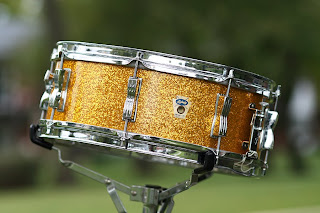
The Ludwig Drum Company and the Slingerland Drum Company were both based in the Chicago metro area. Ludwig was in the city proper and Slingerland was in Niles, a northwestern suburb. The companies were relatively close to each other, about 10 miles apart as the crow flies. Both Bud Slingerland and Bill Ludwig knew each other and they shared a history of competitiveness.
Slingerland, largely because of Gene Krupa, ruled the roost in the 1930s and 40s. It seemed like almost everyone, particularly big band drummers, played Slingerland Drums. Bill Ludwig did his best to compete, signing such drum stars as Buddy Rich in the late 40s. But the Slingerland Radio King snare drum was the desired drum of choice. The solid maple shell was practically a work of art and the hardware was second to none.
The 1960s saw a seismic shift in the cultural scene, largely due to the Beatles and the British Invasion. Rock was the "Now Sound" and Ludwig, unlike Slingerland, was quick to jump on the trend. Ludwig featured prominent jazz and rock players in their advertisements and catalogs. Slingerland, on the other hand, stressed their stable of Jazz Drummers. Indeed, even as late as 1968, Slingerland featured one (1) rock drummer in their catalog, Tom Schiffour of the Shadows of Knight.
But it was in the arena of snare drum sales that these two giants went toe to toe. Ludwig pitched the metal Supraphonic 400 (see blog entry Jan. 5th 2011) as their best selling snare drum. Slingerland countered with the snare drum you see pictured above, the Radio King Chrome shell snare drum.
The ad copy Ludwig and Slingerland used for their respective drums tells volumes about the marketing direction each company pursued. The ad for the Ludwig Supraphonic 400 describes it as " totally modern in sound and concept." The drum was " just plain explosive, offering instant response and undistorted snare action." "Its one piece Acousti-Perfect shell, made of heavy gauge metal with flanged hoops and a center bead for triple strength, was the utmost in modern snare drum design."
Slingerland countered by praising the Radio King as " a swinging drum with a solid brass shell and no sound distorting center bead." The drum was described as " a real buy" in the Slingerland catalog. This Radio King came in an 8 or 10 lug version with brass stick saver hoops that were guaranteed not to rust or break for life. The Ludwig Supraphonic 400, in contrast, was originally made of brass, but by the early 60s, the company simply started making them of any metal that was available at the time.
The results of this sales competition were somewhat lopsided. It can be argued, and quite convincingly I believe, that the Ludwig Supraphonic 400 was the most popular snare drum of the 1960s. It was offered as standard equipment with the Classic, Downbeat, New Yorker, and Traveler drum kits. Its recorded history is well known among drum aficionados.
And the Slingerland Radio King chrome snare drum? Well, history has not been kind to this model. Slingerland fumbled the ball badly with this drum. The ad campaign stressed its history rather than " the sound of today." Ludwig was quick to recognize that rock music was no passing fad and that to ignore its sales potential was foolish.
When all is said and done, this Radio King remains a fine, but neglected drum. But no apologies are needed. The Radio King chrome snare drum can hold its own in any musical situation. Incidentally, stick shredder hoops can used in place of the stick savers. This makes it a different animal. In any case, the drum sounds terrific.




